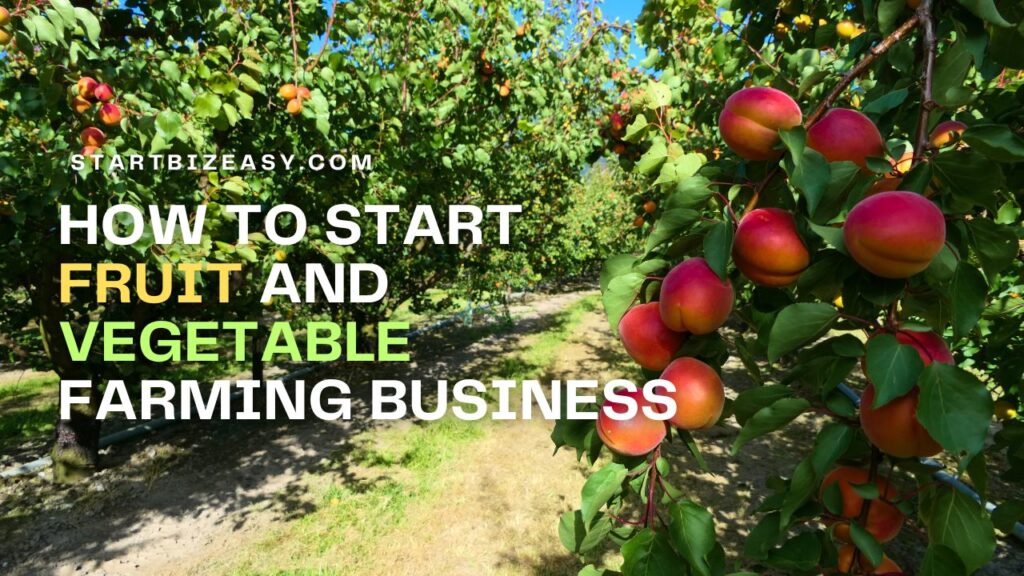
Fruit and vegetable farming business involves the cultivation of various fruits and vegetables for commercial purposes. It encompasses activities such as land preparation, planting, irrigation, pest and disease management, harvesting, and marketing of produce.
This type of business can range from small-scale family farms to large commercial operations, catering to local, regional, or even international markets.
Successful fruit and vegetable farming businesses require careful planning, investment in resources and infrastructure, and knowledge of crop cultivation techniques.
Though this fruit and vegetable farming business is profitable, farmers must consider factors such as soil quality, climate conditions, water availability, and market demand when selecting crops to grow. Additionally, sustainable farming practices and adherence to food safety standards are essential for long-term viability and success in the industry.
In this article, we will guide you through the key components needed to start a successful fruit and vegetable farming business.
Here is how to start Fruit and Vegetable farming business
Table of Contents
1. Crop Selection:
Choosing the right mix of crops is a critical decision in your fruit and vegetable farming business. To do this effectively, you should consider several key factors.
First, evaluate market demand. Research your target markets to understand consumer preferences, trends, and buying patterns. Knowing what fruits and vegetables are in high demand helps you focus on crops that are likely to sell well and bring in higher profits. For example, tomatoes and strawberries often have a strong market presence due to their versatility and popularity.
In Nigeria, several fruits and vegetables are in high demand due to their popularity in local cuisine, nutritional value, and market availability. Here are some of the most sought-after options:
- Tomatoes: A staple in Nigerian cooking, tomatoes are essential for making stews, soups, and sauces. Their high demand is driven by their versatility and frequent use in various dishes.
- Peppers: Both sweet peppers (bell peppers) and hot peppers (chili peppers) are in high demand. They are widely used in Nigerian cuisine to add flavor and heat to dishes.
- Onions: Another staple ingredient, onions are used in nearly every Nigerian dish. Their demand remains consistently high due to their essential role in cooking.
- Okra: Known locally as “ladies’ fingers,” okra is used in soups and stews, such as the popular okra soup. Its high nutritional value and culinary versatility make it a favorite.
- Lettuce: With the growing trend of healthy eating and salads, lettuce has seen increased demand, especially in urban areas.
- Carrots: Carrots are popular for their use in various dishes, including soups, stews, and salads. They are also valued for their health benefits.
- Cucumbers: Often eaten fresh or in salads, cucumbers are appreciated for their refreshing taste and hydrating properties.
- Spinach (Efo Tete): A leafy green vegetable used in many traditional Nigerian dishes, spinach is prized for its nutritional benefits and versatility.
- Watermelon: Popular for its refreshing taste, watermelon is a favorite fruit, especially during hot weather.
- Bananas: Widely consumed as a snack or dessert, bananas are always in demand due to their sweetness, convenience, and nutritional value.
- Oranges: Valued for their high vitamin C content and refreshing taste, oranges are a popular fruit choice.
- Pineapples: Pineapples are loved for their sweet and tangy flavor and are commonly eaten fresh or used in beverages and desserts.
These fruits and vegetables are integral to Nigerian diets and have a strong market presence. As a farmer, focusing on these high-demand crops can help you tap into the robust local market and ensure a steady demand for your produce.
Next, consider climate suitability. Each crop has specific climate requirements for optimal growth. You’ll need to account for temperature, rainfall, humidity, and sunlight. For instance, peppers thrive in warm climates with plenty of sunlight, while lettuce prefers cooler, moist conditions. By selecting crops that are well-suited to your local climate, you can ensure healthier plants and better yields.
Soil conditions are another important factor. Different crops thrive in different types of soil. Conduct soil tests to determine the texture, fertility, pH level, drainage, and nutrient content of your soil. Crops like cucumbers and strawberries need fertile, well-drained soil, whereas apples prefer well-drained soil with distinct seasonal changes. Matching your crops to the existing soil conditions can significantly enhance their growth and productivity.
By carefully selecting your crops based on market demand, climate suitability, and soil conditions, you can create a successful and sustainable fruit and vegetable farming business. This thoughtful approach helps ensure that your efforts and resources are invested in the most promising and productive crops.
2. Land Selection:
In Nigeria, several states are particularly well-suited for fruit and vegetable farming due to their favorable climate, soil conditions, and access to water. These states include:
- Benue State: Often referred to as the “Food Basket of the Nation,” Benue State has fertile soil and a favorable climate for a wide variety of fruits and vegetables. Crops such as tomatoes, oranges, mangoes, and yams thrive here.
- Kaduna State: Known for its agricultural productivity, Kaduna State offers suitable conditions for growing vegetables like tomatoes, onions, and peppers. The state’s diverse agro-ecological zones support the cultivation of different crops.
- Kano State: With its well-developed irrigation infrastructure, Kano State is a major producer of tomatoes, peppers, onions, and other vegetables. The state’s dry season farming (using irrigation) ensures a year-round supply of produce.
- Ogun State: This state has rich, fertile soil and a conducive climate for growing fruits such as pineapples, citrus, and bananas, as well as vegetables like tomatoes, peppers, and leafy greens.
- Oyo State: Oyo State’s favorable climatic conditions and fertile soil support the cultivation of a variety of fruits and vegetables, including tomatoes, cucumbers, and citrus fruits.
- Plateau State: Known for its unique temperate climate, Plateau State is ideal for growing temperate fruits like strawberries, apples, and grapes, as well as a variety of vegetables including cabbage, carrots, and Irish potatoes.
- Niger State: With its vast arable land and favorable weather conditions, Niger State is suitable for growing a range of crops, including vegetables like tomatoes, peppers, and leafy greens, as well as fruits like mangoes and citrus.
- Cross River State: This state has a tropical climate and fertile soil that support the cultivation of a variety of fruits such as pineapples, bananas, and citrus, along with vegetables like peppers and tomatoes.
These states benefit from a combination of fertile soils, suitable climatic conditions, and, in some cases, well-developed irrigation systems, making them ideal for fruit and vegetable farming. Farmers in these regions can take advantage of these natural resources to produce high-quality crops that meet both local and international market demands.
Once a suitable land is secured, preparation begins with clearing the area of vegetation, weeds, and debris. Land preparation is a crucial step in ensuring your crops have the best possible start. It involves several key activities aimed at creating optimal growing conditions.
First, you’ll begin with plowing, which is the process of turning over the soil. This breaks up compacted layers, improves soil aeration, and helps in the incorporation of organic matter.
Next, you’ll move on to tilling. Tilling refines the soil further by breaking it down into smaller, more manageable particles. This step is essential because it creates a finer soil structure, which facilitates root penetration and promotes better water retention and drainage.
Another important aspect of land preparation is soil amendment. Here, you’ll add necessary nutrients and organic matter to the soil. This could include compost, manure, or specific fertilizers tailored to the needs of the crops you plan to grow. Soil testing is often recommended at this stage to understand the nutrient profile and pH level of your soil, allowing you to make precise amendments.
By carefully preparing your land through these activities, you create an environment where your crops can thrive, ensuring healthier growth and higher yields.
3. Planting and Cultivation:
Planting and cultivation are pivotal stages in your farming process. Once your land is prepared, you’ll begin by sowing seeds or planting seedlings in the carefully prepared fields. This step requires precision to ensure each plant has enough space to grow and access to necessary nutrients and sunlight.
After planting, you’ll implement various cultivation practices to nurture your crops. Regular watering is essential to keep the soil moist and support plant growth. Depending on your crop type and local climate, you’ll need to establish a consistent watering schedule to avoid both drought stress and overwatering.
Fertilizing is another critical task. By providing your plants with additional nutrients, you help them grow strong and healthy. This might involve using organic compost, synthetic fertilizers, or a combination of both, depending on your farming philosophy and the specific needs of your crops.
Weeding is necessary to prevent unwanted plants from competing with your crops for nutrients, water, and light. Regular weeding helps maintain a clean and healthy growing environment.
Pest control is also vital to protect your crops from insects, diseases, and other pests. This might include natural methods, such as introducing beneficial insects or using organic sprays, or more conventional approaches, such as chemical pesticides. The key is to monitor your crops closely and address any issues promptly to prevent widespread damage.
By diligently carrying out these planting and cultivation practices, you’ll be setting the stage for a bountiful harvest, ensuring your crops grow to their full potential.
4. Irrigation and Water Management:
Irrigation is essential for ensuring your crops receive the water they need to thrive. By implementing an effective irrigation system, you can maintain consistent moisture levels in the soil, which is crucial for the optimal growth of your plants.
Drip irrigation is one method you might consider. This system delivers water directly to the roots of your plants through a network of tubes and emitters, minimizing water waste and ensuring each plant gets the exact amount of water it needs. Drip irrigation is highly efficient and particularly useful in areas with limited water resources.
Sprinkler systems are another option. These systems distribute water across your fields through overhead sprinklers, mimicking natural rainfall. Sprinklers are versatile and can cover large areas, making them suitable for various crop types. They are also relatively easy to install and maintain.
Furrow irrigation involves creating small channels along the rows of your crops. Water flows through these furrows and seeps into the soil, providing moisture to the plant roots. This method is simple and cost-effective, especially for larger fields with row crops.
Choosing the right irrigation system for your farm depends on several factors, including your crop types, field size, and water availability.
In addition to the choice of irrigation system, water management strategies should include practices like mulching and crop rotation. Mulching helps retain soil moisture by reducing evaporation and controlling weed growth. Crop rotation, involving alternating different crops in the same field, can improve soil structure and water retention, leading to more efficient water use over time.
Efficient irrigation and water management also consider the quality of the water being used. Ensuring that the water is free from contaminants and has an appropriate pH level is vital for crop health. Regular water testing can help identify any issues that need to be addressed, such as salinity or the presence of harmful pathogens.
Implementing these practices not only conserves water but also enhances crop health and productivity, ultimately leading to higher yields and better-quality produce. Effective irrigation and water management are essential components of sustainable and profitable fruit and vegetable farming.
5. Pest and Disease Management:
Pest and disease management is a crucial aspect of maintaining healthy crops and ensuring a successful harvest. By keeping a close eye on your crops, you can identify any signs of pests, diseases, or weeds early and take action to mitigate their impact.
Monitoring is your first line of defense. Regularly inspect your fields for any signs of trouble, such as unusual spots on leaves, stunted growth, or visible pests. Early detection allows you to address issues before they become severe and spread.
Integrated Pest Management (IPM) is a comprehensive approach you can use to manage pests sustainably. IPM combines different strategies and practices to keep pest populations at manageable levels while minimizing the use of harmful chemicals. This might include biological control methods, such as introducing natural predators of pests, and cultural practices, like crop rotation, to disrupt pest life cycles.
Crop rotation is another effective technique. By changing the types of crops grown in a particular field each season, you can reduce the buildup of pests and diseases that prefer specific plants. This practice helps to maintain soil health and reduce the dependency on chemical controls.
When necessary, the use of pesticides can be considered. Organic pesticides, derived from natural sources, can be effective and are less harmful to the environment and non-target organisms. However, in some cases, chemical pesticides might be required to control more severe infestations. When using chemical pesticides, it’s important to follow guidelines and regulations to ensure they are applied safely and effectively, minimizing any negative impact on the environment.
By combining these strategies, you can effectively manage pests and diseases, keeping your crops healthy and your farm productive. Regular monitoring, along with proactive and integrated approaches, will help you maintain control over potential threats and ensure the long-term sustainability of your farming operation.
6. Harvesting and Post-Harvest Handling:
Harvesting and post-harvest handling are critical processes in fruit and vegetable farming that significantly impact the quality, shelf life, and marketability of the produce. These stages require careful planning and execution to ensure that the fruits and vegetables reach consumers in optimal condition.
Harvesting at the Right Maturity Stage
Harvesting fruits and vegetables at the right maturity stage is crucial for maintaining their quality. Each type of fruit and vegetable has an optimal harvest time when it reaches its peak flavor, texture, and nutritional value. Harvesting too early can result in produce that lacks flavor and may not ripen properly, while harvesting too late can lead to overripe produce that is prone to spoilage and damage. Farmers need to be knowledgeable about the specific maturity indicators for each crop, such as color, size, firmness, and taste, to determine the ideal time for harvesting.
Careful Handling During Harvesting
During harvesting, fruits and vegetables should be handled carefully to minimize physical damage, such as bruising, cuts, and abrasions, which can lead to spoilage and reduce market value. Using appropriate harvesting tools and techniques, such as sharp knives or pruning shears for cutting and gentle picking methods for delicate produce, helps prevent damage. Workers should be trained to handle produce gently and place it in clean, cushioned containers to avoid unnecessary impact.
Proper Post-Harvest Handling
Once harvested, proper post-harvest handling is essential to preserve the freshness and quality of fruits and vegetables. This includes a series of steps such as cleaning, sorting, grading, and cooling.
- Cleaning: Removing dirt, debris, and any potential contaminants from the surface of the produce is important to maintain hygiene and quality. This can be done through washing with clean water or using gentle brushes.
- Sorting and Grading: Sorting involves separating produce based on size, color, and quality. Grading ensures that only the best-quality produce reaches the market, while lower-grade produce can be used for processing or other purposes.
- Cooling: Rapid cooling of harvested produce slows down respiration and metabolic processes, reducing the rate of spoilage and extending shelf life. Techniques such as hydro-cooling (using cold water), forced-air cooling, and vacuum cooling can be used, depending on the type of produce.
Storage and Packaging
Proper storage conditions are crucial for maintaining the quality and extending the shelf life of fruits and vegetables. Storage facilities should provide optimal temperature, humidity, and ventilation for different types of produce. For instance, some fruits like apples and citrus require cool, slightly humid conditions, while others like tomatoes and tropical fruits need warmer temperatures.
Packaging also plays a significant role in protecting produce during storage and transportation. Suitable packaging materials and methods, such as plastic crates, cartons, or breathable bags, help prevent damage, contamination, and moisture loss. Packaging should also consider factors like ease of handling, stacking, and labeling for efficient distribution.
Transportation
Efficient and careful transportation is essential to ensure that fruits and vegetables reach their destination in good condition. Produce should be transported in clean, well-ventilated vehicles with appropriate temperature control to prevent spoilage. Minimizing transit time and handling during transportation helps maintain freshness and quality.
Final Steps
The final steps in post-harvest handling involve marketing and distribution. Ensuring that produce is delivered to markets, retailers, or consumers as quickly and efficiently as possible is key to preserving its quality. Farmers can leverage modern logistics and supply chain management techniques to streamline this process.
7. Marketing and Distribution:
Marketing and distribution/sales are vital components of your farming business, ensuring that the fruits and vegetables you grow reach your customers and generate income. Developing effective marketing strategies helps you promote your farm products and connect with your target audience through various channels.
First, you’ll want to identify your target customers. Consider who is most likely to buy your produce, whether it’s local consumers looking for fresh, organic options, restaurants seeking quality ingredients, or grocery stores needing a reliable supplier. Understanding your market helps you tailor your marketing efforts to meet their needs and preferences.
Farmers’ markets are an excellent way to sell directly to consumers. These markets allow you to engage with customers, offer samples, and receive immediate feedback. They also provide an opportunity to build relationships and loyalty with regular shoppers who appreciate locally grown produce.
Grocery stores and supermarkets offer another significant sales channel. By establishing partnerships with these retailers, you can secure a steady demand for your products. Ensure your produce meets their quality and quantity requirements, and be prepared to maintain consistent supply to build trust and reliability.
Restaurants are always in search of fresh, high-quality ingredients. Approach local eateries and offer samples of your produce. Highlight the benefits of using fresh, locally grown fruits and vegetables in their dishes. Establishing relationships with chefs and restaurant owners can lead to long-term contracts and steady sales.
Community-supported agriculture (CSA) programs are another effective way to market your farm products. In a CSA, customers pay upfront for a share of your harvest, receiving regular deliveries of fresh produce throughout the growing season. This model provides you with early season capital and a guaranteed market, while customers enjoy fresh, seasonal produce and a direct connection to their food source.
Online platforms and social media have become powerful tools for marketing farm products. Create a website or social media profiles to showcase your farm, share stories and photos, and update followers on what’s in season. Online sales through e-commerce platforms or home delivery services can expand your reach beyond local markets, allowing you to connect with a broader audience.
Developing a marketing strategy that incorporates these various channels ensures that you can reach a diverse customer base and maximize your sales opportunities. By effectively promoting your farm products, you can build a loyal customer base, increase your farm’s visibility, and drive the success of your business.
8. Business Management:
Business management is the backbone of a successful farming operation, encompassing a range of activities that ensure your farm runs smoothly, remains profitable, and is sustainable in the long term. Effective management involves overseeing daily operations, managing finances, and leading your team. Here’s a closer look at what this entails:
First, budgeting is crucial. By creating a detailed budget, you can plan for both expected and unexpected expenses. This includes costs for seeds, fertilizers, equipment, labor, and maintenance. A well-structured budget helps you allocate resources efficiently, avoid overspending, and ensure you have enough capital to invest in critical areas of your farm.
Record-keeping is another essential aspect. Keeping accurate records of your farm’s operations allows you to track your expenses, monitor crop yields, and analyze your financial performance. This data is invaluable for making informed decisions, identifying trends, and improving future crop planning and budgeting. Good record-keeping also helps you comply with regulations and prepare for tax season.
Crop planning is vital for maximizing your farm’s productivity and profitability. By planning which crops to grow, when to plant them, and how to rotate them, you can optimize the use of your land and resources. Effective crop planning takes into account factors such as market demand, climate conditions, and soil health, ensuring you grow the right crops at the right time.
Workforce management involves hiring, training, and supervising your team. Having a skilled and motivated workforce is key to your farm’s success. This includes recruiting the right people for different tasks, providing training to ensure they understand their roles and responsibilities, and fostering a positive work environment. Effective communication and leadership are essential to maintaining high morale and productivity.
Additionally, managing farm operations requires coordinating various activities to ensure everything runs smoothly. This includes scheduling planting and harvesting times, maintaining equipment, and ensuring that irrigation and pest control measures are in place. Efficient management of these operations ensures that your crops grow healthily and are harvested at peak quality.
9. Compliance and Regulations:
Compliance and regulations are critical aspects of running a farming business, ensuring that operations meet legal requirements, maintain food safety standards, and contribute to environmental sustainability.
In Nigeria, agricultural activities are regulated by several government agencies at both the federal and state levels. These agencies play crucial roles in formulating policies, implementing regulations, providing support services, and promoting agricultural development. Some of the key government agencies regulating agricultural activities in Nigeria include:
- Federal Ministry of Agriculture and Rural Development (FMARD): FMARD is the primary federal government agency responsible for agricultural development and rural transformation in Nigeria. It formulates agricultural policies, coordinates agricultural programs and projects, and provides support services to farmers and agribusinesses nationwide.
- National Agricultural Extension Research and Liaison Services (NAERLS): NAERLS is responsible for promoting agricultural extension services, technology transfer, and farmer education. It conducts research, develops extension materials, and trains extension workers to disseminate agricultural innovations and best practices to farmers across the country.
- National Agricultural Seeds Council (NASC): NASC regulates the production, marketing, and distribution of agricultural seeds in Nigeria. It ensures the availability of high-quality seeds, certifies seed producers and dealers, and monitors seed quality to safeguard farmers’ interests and promote agricultural productivity.
- National Agricultural Quarantine Service (NAQS): NAQS is tasked with preventing the introduction and spread of pests and diseases that could harm agricultural crops, livestock, and the environment. It enforces quarantine measures, conducts inspections, and certifies the movement of agricultural commodities to protect Nigeria’s agriculture sector from biological threats.
- Nigerian Agricultural Insurance Corporation (NAIC): NAIC provides agricultural insurance products and services to protect farmers against losses caused by natural disasters, pests, diseases, and market fluctuations. It aims to enhance farmers’ resilience to risks and promote investment in agriculture by mitigating financial uncertainties.
- National Horticultural Research Institute (NIHORT): NIHORT conducts research and development activities to promote the cultivation, processing, and marketing of horticultural crops such as fruits, vegetables, ornamental plants, and spices. It provides technical support to horticultural farmers and stakeholders to improve crop productivity and competitiveness.
- State Ministries of Agriculture: Each state in Nigeria has its own Ministry of Agriculture responsible for implementing agricultural policies and programs at the state level. These ministries collaborate with federal agencies, local governments, farmers’ associations, and other stakeholders to support agricultural development, extension services, and rural empowerment initiatives within their respective states.
- Agricultural Development Programs (ADPs): ADPs are state-level agencies that implement agricultural extension services, technology transfer, and capacity-building programs at the grassroots level. They work closely with farmers, farmer groups, and community-based organizations to disseminate agricultural innovations, improve productivity, and enhance food security in rural areas.
Adhering to agricultural regulations involves complying with laws and regulations set forth by government agencies at the local, state, and federal levels. These regulations cover various aspects of farming, including land use, water rights, pesticide use, and animal welfare. By following these regulations, farmers can avoid fines, penalties, and legal issues while operating within the bounds of the law.
Ensuring food safety is paramount in farming, particularly when producing crops for human consumption. Farmers must adhere to food safety standards and guidelines established by regulatory agencies to minimize the risk of contamination and ensure the safety of their products. This includes implementing good agricultural practices (GAPs), proper handling and storage procedures, and regular testing for contaminants such as pathogens and pesticides.
Obtaining necessary permits and certifications is often required to operate a farming business legally. This may include permits for land use, water rights, pesticide application, and food processing facilities, among others. Additionally, certifications such as organic or fair trade certification may be sought to differentiate products in the market and appeal to certain consumer preferences.
Implementing best practices for environmental stewardship and sustainability is increasingly important in modern agriculture. Farmers must minimize their environmental footprint by conserving natural resources, reducing pollution, and preserving biodiversity. This may involve practices such as soil conservation, water conservation, integrated pest management (IPM), and sustainable crop rotation. By adopting sustainable farming practices, farmers can protect the environment, enhance soil health, and ensure the long-term viability of their operations.
Overall, compliance and regulations play a crucial role in farming, guiding farmers in operating responsibly, ethically, and sustainably. By adhering to agricultural regulations, ensuring food safety, obtaining necessary permits and certifications, and implementing best practices for environmental stewardship, farmers can protect their businesses, their communities, and the environment while contributing to a more sustainable food system.
How much can I use to start a Fruit and Vegetable Farming Business?
To start a fruit and vegetable business on a profitable scale, you will need nothing less than N3 million Naira.
Note that the amount of money needed to start a fruit and vegetable farming business in Nigeria can vary depending on several factors, including the scale of the operation, land acquisition costs, equipment and machinery expenses, inputs such as seeds and fertilizers, labor costs, and marketing expenses. Additionally, the type of crops you intend to grow and the farming techniques you plan to employ can also impact startup costs.
Here are the items the capital will be spent on:
- Land Acquisition: The cost of acquiring or leasing farmland for cultivation can vary depending on location, soil quality, and accessibility. Consider factors such as land size, proximity to markets, and availability of water sources when budgeting for land expenses.
- Infrastructure and Facilities: Expenses related to setting up infrastructure and facilities, such as irrigation systems, fencing, storage facilities, greenhouses (if applicable), and farm equipment sheds, should be taken into account.
- Equipment and Machinery: Investment in essential farming equipment and machinery, including tractors, plows, harrows, seeders, sprayers, and harvesting equipment, is necessary for efficient farm operations. Consider whether to purchase new or used equipment based on your budget and needs.
- Inputs and Supplies: Budget for the purchase of seeds, seedlings, fertilizers, pesticides, herbicides, fungicides, and other agricultural inputs required for crop production. Additionally, allocate funds for ongoing inputs and supplies needed throughout the growing season.
- Labor Costs: Factor in labor costs for hiring farm workers, supervisors, and seasonal laborers to assist with planting, cultivation, harvesting, and other farm activities. Consider whether to hire permanent staff or utilize seasonal labor based on your production cycle and labor requirements.
- Marketing and Distribution: Allocate funds for marketing and distribution activities to promote your farm products and reach target customers. This may include expenses for packaging materials, branding, transportation, and participation in farmers’ markets or other sales outlets.
- Regulatory Compliance: Budget for expenses related to regulatory compliance, including permits, licenses, certifications, and inspections required to operate a farming business in Nigeria. Ensure compliance with agricultural and environmental regulations to avoid fines or penalties.
- Contingency Fund: Set aside a contingency fund to cover unexpected expenses, emergencies, or cash flow fluctuations that may arise during the startup phase or initial years of operation.
While the initial investment required to start a fruit and vegetable farming business in Nigeria can vary, it’s essential to conduct thorough research, develop a detailed business plan, and accurately estimate startup costs to ensure financial feasibility and sustainability. Consider seeking guidance from agricultural experts, financial advisors, or experienced farmers to refine your budget and make informed decisions about your farming venture.
Read Also:
- How to Start a Fruit and Vegetable Business as a Seller: Your Step-by-Step Guide
- How to Start Fruit Juice Business in Nigeria: The Insider’s Step-By-Step Guide
- Rice Business in Nigeria Made Easy: A Success Guide
Discover more from StartBizEasy
Subscribe to get the latest posts to your email.





